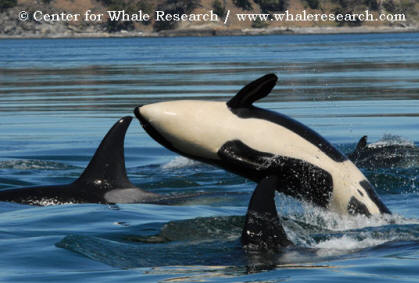|
Adaptations and
General Characteristics
Orcas have adapted many of their
physical and internal characteristics to overcome the challenges of
living and hunting in an aquatic environment. In fact, this is done
so well that they reign supreme predators in the oceans.
General Body Shape and Size
Orcas share the same unique sleek, streamline bodies as other
dolphins have. This characteristic body helps helps them the
glide through the water easily, allowing them to swim faster.
Orcas rank among the fastest mammals alive today, reaching speeds up
to 30 miles per hour. However, this speed cannot be held out
for long periods of time, so they generally swim at speeds of around
four miles per hour.
Males grow to be about 19-22 feet and
to weigh about 8,000-12,000 pounds. Females are much smaller.
They grow to be about 16-19 feet and to weigh about 3,000-8,000
pounds.
Colors
In general, Orcas are black on top and white on bottom. At
first thought, you might not think that this would help to
camouflage them but it does. When looking from above, their
white underbelly is light like the surface of the water. When
looking from above, the black blends in well with the dark bottoms.
Their interrupted color patter contradicts their sleek body shape.
This sometimes makes Orcas unrecognizable to potential prey.

An young male Orca breaching by attributed by
Kelley Balcomb-Bartok
from the Center of Whale Research. Notice that drastic color
changes
from his bottom compared to the tops of the other Orcas.
Saving Oxygen
Since Orcas can dive for longer than ten minutes at a time, it
was necessary for them to come up with some way to conserve oxygen.
Orcas are able to slow their heart beat when diving. This
decreases the demand of oxygen but can be very stressful on the
body. Orcas are also able to from their extremities (tissues
that do not need as much oxygen) and towards their heart, lungs, and
brain (tissues that die off cannot tolerate an absence of oxygen).
They also have a higher concentration of myoglobin (equivalent to
hemoglobin--the protein that carries oxygen in human blood) in their
muscles. This allows them to use their muscles for a longer
period of time without oxygen.
Dealing with Nitrogen
I'm sure that all of you have heard of divers who ascend too
quickly and almost quite literally jump out of the water when they
reach the surface. This is caused when the nitrogen that we
breathe in from the atmosphere turns switches from an aqueous state
to a gaseous state while still in our bodies due to the rapid
decrease in pressure. So how do Orcas deal with this
situation? Orcas are able to shunt air into their throat and nasal
cavity by collapsing their lungs. The tissues inside their
throats and nose are not able to absorb nitrogen, eliminating the
problem.
Conserving Heat
Orcas keep their body temperature at about the same temperature
has humans do. But since Orcas live in water, they loose much
more heat to the environment than we do. In response to this,
Orcas have developed many ways to try and conserve their heat.
First of all, Orcas have a high metabolic rate that generates a lot
of heat just while performing basic life functions. They also
have a thick layer of fat called blubber, as most mammals do.
This layer of fat conserves some heat also. Thirdly, Orcas
have an advanced circulatory system. As discussed, they are
able to shunt blood away from the extremities and towards the center
of their bodies. Along with conserving oxygen, this conserves
heat. They are also able to take advantage of countercurrent
exchange. In their extremities, the arteries are surround by
veins. Heat is transferred from the arteries to the veins,
rather than to the environment. Lastly, because surface area
is always an answer, Orca's reduced limb size equal less surface
area touching the water, meaning less heat lost.
Flippers, Flukes, and Fins
Orcas have have two anterior, ventral pectoral flippers; two
posterior flukes comprising the end of the tail; and one distinct
dorsal fin. All are made of dense connective tissue and do not
have any bone or cartilage in them. All are adaptations to help with
movement in the water. The flippers are used for steering, the
flukes for stopping, and the fin to help in stability. The fin
grows at a very allometric rate once it reaches puberty, especially
in males. They can grow up to six feet or longer. The
flukes grow to be very large also, some getter up to four feet or
longer. Many orcas have fins and flukes that are bent.
This is because without bone or cartilage, the connective tissue can
simply not support the sheer mass of them.

A picture of a dorsal fin of an adult male Orca attributed by
Mike Holman of West Rock Alaska Tours. Notice how large it is.
Patches
Orcas have a patch of varying shades of white to grey just below
their dorsal fin. It is known as their saddle patch. In
transient Orcas, the saddle patch sits lower on the anterior side
than in residents. Each dorsal fin and saddle patch
combination is so unique to each Orca that scientists can recognize
the Orca just by seeing them. Orca also have a distinctive
white patches over their eyes. |